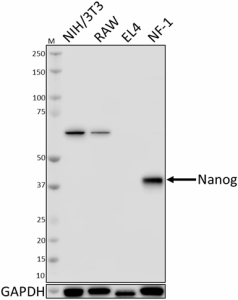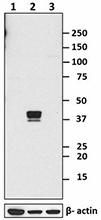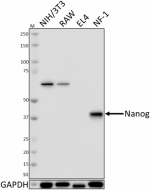- Clone
- SER211 (See other available formats)
- Regulatory Status
- RUO
- Other Names
- Homeobox Transcription Factor Nanog, Nanog Homeobox, Homeobox Protein NANOG, Homeobox Transcription Factor Nanog-Delta 48, ENK, ecat4
- Isotype
- Rat IgG2a, κ
- Ave. Rating
- Submit a Review
- Product Citations
- publications

-

Total cell lysates (15 µg total protein) from NIH/3T3, Raw264.7, EL4 (negative controls) and NF-1 (positive control) cells were resolved by 4-12% Bis-Tris gel electrophoresis, transferred to a nitrocellulose membrane, and probed with 1 µg/mL of Purified anti-Nanog Antibody, clone SER211, overnight at 4°C. Proteins were visualized by chemiluminescence detection using HRP goat anti-rat IgG Antibody (Cat. No. 405405) at a 1:3000 dilution. Direct-Blot™ HRP anti-GAPDH Antibody (Cat. No. 607904) was used as a loading control at a 1:50000 dilution (lower). Lane M: Molecular Weight marker. -
Total cell lysate from NTERA-2 cells (lane 1, 15 µg), NF-1 cells (lane 2, 15 µg) and HeLa (lane 3, 15 µg) were resolved by electrophoresis (4-20% Tris-Glycine gel), transferred to nitrocellulose, and probed with purified anti-Nanog antibody (clone SER211). Proteins were visualized using an HRP Goat anti-rat IgG Antibody and chemiluminescence detection. Direct-Blot™ HRP anti-β-actin antibody (clone 2F1-1) was used as a loading control.
| Cat # | Size | Price | Quantity Check Availability | Save | ||
|---|---|---|---|---|---|---|
| 678102 | 100 µg | 231€ | ||||
Nanog is a transcription factor that plays a key role in the maintenance of embryonic stem cells pluripotency and self-renewal in embryonic stem cells. Nanog expression is regulated by other transcription factors such as Sox2 and Oct-4. Nanog also plays a role in epithelial malignancy. Nanog is enriched in cancer stem cells and the ablation of Nanog is sufficient to reduce the cancer stem cell pool.
Product DetailsProduct Details
- Verified Reactivity
- Mouse
- Antibody Type
- Monoclonal
- Host Species
- Rat
- Immunogen
- Mouse Nanog.
- Formulation
- Phosphate-buffered solution, pH 7.2, containing 0.09% sodium azide.
- Preparation
- The antibody was purified by affinity chromatography.
- Concentration
- 0.5 mg/ml
- Storage & Handling
- The antibody solution should be stored undiluted between 2°C and 8°C.
- Application
-
WB - Quality tested
- Recommended Usage
-
Each lot of this antibody is quality control tested by Western blotting. For Western blotting, the suggested use of this reagent is 0.5 - 2.0 µg per ml. It is recommended that the reagent be titrated for optimal performance for each application.
- Application Notes
-
This clone is not recommended for ChIP (Chromatin Immunoprecipitation) assays (as determined by in-house testing).
A non-specific band of roughly 60 kD was observed in some lysates during product development testing. - RRID
-
AB_2565914 (BioLegend Cat. No. 678102)
Antigen Details
- Structure
- 305 amino acids wtih a predicted molecular weight of approximately 35 kD.
- Distribution
-
Nuclear and cytoplasmic. Expressed by embryonic stem (ES) cells or cancer stem cells. Expression decreases with ES differentiation.
- Function
- Transcription regulator that plays key roles in the maintenance of pluripotency and self-renewal in embryonic stem cells.
- Interaction
- Interacts with SMAD1, SALL4, and ZNF281/ZFP281.
- Cell Type
- Embryonic Stem Cells
- Biology Area
- Apoptosis/Tumor Suppressors/Cell Death, Cell Biology, Cell Cycle/DNA Replication, Signal Transduction, Stem Cells, Transcription Factors
- Antigen References
-
1. Hwang CC, et al. 2014. PLoS One 9:e105676.
2. Torres-Padilla ME, et al. 2014. Development 141:2173.
3. Xie X, et al. 2014. Int. J. Cancer 12:2741.
4. Wang ML, et al. 2013. Onco. Targets Ther. 6:1207.
5. Kim J, et al. 2008. Cell 132:1049.
6. Takahashi K, et al. 2007. Nat. Protoc. 2:3081.
7. Yu J, et al. 2007. Science 318:1917. - Gene ID
- 71950 View all products for this Gene ID
- UniProt
- View information about Nanog on UniProt.org
Related FAQs
Other Formats
View All Nanog Reagents Request Custom Conjugation| Description | Clone | Applications |
|---|---|---|
| Purified anti-Nanog | SER211 | WB |
Compare Data Across All Formats
This data display is provided for general comparisons between formats.
Your actual data may vary due to variations in samples, target cells, instruments and their settings, staining conditions, and other factors.
If you need assistance with selecting the best format contact our expert technical support team.
 Login / Register
Login / Register 










Follow Us